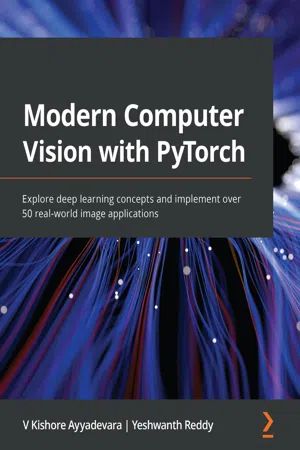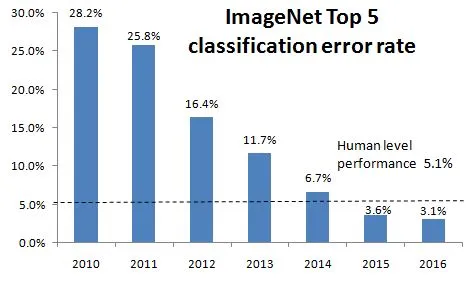
Modern Computer Vision with PyTorch
Explore deep learning concepts and implement over 50 real-world image applications
- 824 pages
- English
- ePUB (mobile friendly)
- Available on iOS & Android
Modern Computer Vision with PyTorch
Explore deep learning concepts and implement over 50 real-world image applications
About this book
Get to grips with deep learning techniques for building image processing applications using PyTorch with the help of code notebooks and test questions
Key Features
- Implement solutions to 50 real-world computer vision applications using PyTorch
- Understand the theory and working mechanisms of neural network architectures and their implementation
- Discover best practices using a custom library created especially for this book
Book Description
Deep learning is the driving force behind many recent advances in various computer vision (CV) applications. This book takes a hands-on approach to help you to solve over 50 CV problems using PyTorch1.x on real-world datasets.
You'll start by building a neural network (NN) from scratch using NumPy and PyTorch and discover best practices for tweaking its hyperparameters. You'll then perform image classification using convolutional neural networks and transfer learning and understand how they work. As you progress, you'll implement multiple use cases of 2D and 3D multi-object detection, segmentation, human-pose-estimation by learning about the R-CNN family, SSD, YOLO, U-Net architectures, and the Detectron2 platform. The book will also guide you in performing facial expression swapping, generating new faces, and manipulating facial expressions as you explore autoencoders and modern generative adversarial networks. You'll learn how to combine CV with NLP techniques, such as LSTM and transformer, and RL techniques, such as Deep Q-learning, to implement OCR, image captioning, object detection, and a self-driving car agent. Finally, you'll move your NN model to production on the AWS Cloud.
By the end of this book, you'll be able to leverage modern NN architectures to solve over 50 real-world CV problems confidently.
What you will learn
- Train a NN from scratch with NumPy and PyTorch
- Implement 2D and 3D multi-object detection and segmentation
- Generate digits and DeepFakes with autoencoders and advanced GANs
- Manipulate images using CycleGAN, Pix2PixGAN, StyleGAN2, and SRGAN
- Combine CV with NLP to perform OCR, image captioning, and object detection
- Combine CV with reinforcement learning to build agents that play pong and self-drive a car
- Deploy a deep learning model on the AWS server using FastAPI and Docker
- Implement over 35 NN architectures and common OpenCV utilities
Who this book is for
This book is for beginners to PyTorch and intermediate-level machine learning practitioners who are looking to get well-versed with computer vision techniques using deep learning and PyTorch. If you are just getting started with neural networks, you'll find the use cases accompanied by notebooks in GitHub present in this book useful. Basic knowledge of the Python programming language and machine learning is all you need to get started with this book.
Frequently asked questions
- Essential is ideal for learners and professionals who enjoy exploring a wide range of subjects. Access the Essential Library with 800,000+ trusted titles and best-sellers across business, personal growth, and the humanities. Includes unlimited reading time and Standard Read Aloud voice.
- Complete: Perfect for advanced learners and researchers needing full, unrestricted access. Unlock 1.4M+ books across hundreds of subjects, including academic and specialized titles. The Complete Plan also includes advanced features like Premium Read Aloud and Research Assistant.
Please note we cannot support devices running on iOS 13 and Android 7 or earlier. Learn more about using the app.
Information
- Chapter 1, Artificial Neural Network Fundamentals
- Chapter 2, PyTorch Fundamentals
- Chapter 3, Building a Deep Neural Network with PyTorch

- Comparing AI and traditional machine learning
- Learning about the artificial neural network building blocks
- Implementing feedforward propagation
- Implementing backpropagation
- Putting feedforward propagation and backpropagation together
- Understanding the impact of the learning rate
- Summarizing the training process of a neural network
Comparing AI and traditional machine learning



Table of contents
- Title Page
- Copyright and Credits
- Dedication
- About Packt
- Contributors
- Preface
- Section 1 - Fundamentals of Deep Learning for Computer Vision
- Artificial Neural Network Fundamentals
- PyTorch Fundamentals
- Building a Deep Neural Network with PyTorch
- Section 2 - Object Classification and Detection
- Introducing Convolutional Neural Networks
- Transfer Learning for Image Classification
- Practical Aspects of Image Classification
- Basics of Object Detection
- Advanced Object Detection
- Image Segmentation
- Applications of Object Detection and Segmentation
- Section 3 - Image Manipulation
- Autoencoders and Image Manipulation
- Image Generation Using GANs
- Advanced GANs to Manipulate Images
- Section 4 - Combining Computer Vision with Other Techniques
- Training with Minimal Data Points
- Combining Computer Vision and NLP Techniques
- Combining Computer Vision and Reinforcement Learning
- Moving a Model to Production
- Using OpenCV Utilities for Image Analysis
- Appendix
- Other Books You May Enjoy